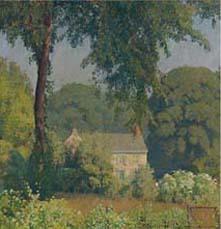Artist Profile
Daniel Garber
- Lived:
- 1880-1956
- Worked:
- New Hope, PA, Chester Springs, PA
- Style:
- Landscape, Figure, Still life, Art education
The American artist Daniel Garber was a leading figure in the Pennsylvania School of Landscape Painting, also known as the Pennsylvania Impressionists, a group centered around the village of New Hope in Bucks County, Pennsylvania. Born in North Manchester, Indiana, Garber began his formal art training at the Art Academy of Cincinnati in 1897 where he studied for one year with landscape and figure painter Vincent Nowottny and fraternized with the followers of Frank Duveneck known as the “Duveneck Boys.” Through the Duveneck connection, Garber was exposed to less academic influences, and he adopted the Impressionist aesthetics of the Ten American Painters upon that group’s showing in Cincinnati in 1898. Garber continued his studies in the summers of 1899 and 1900 at the Darby School in Fort Washington, Pennsylvania. There the emphasis was upon landscape painting, and his teachers Hugh Breckenridge and Thomas Anshutz encouraged their students to experiment. From 1899 until 1905 Garber studied at the Pennsylvania Academy of the Fine Arts in Philadelphia under Anshutz, William Merritt Chase, and Cecilia Beaux. Garber took many of his classes at night to accommodate his work as an illustrator, commercial artist, and portrait painter. Such work included displays for department stores and cover designs for McClure’s, Scribner’s, Harper’s Bazaar, and The Century magazines.
Soon Garber’s easel paintings began to attract favorable notice. In 1902 two of his portraits were accepted into the Pennsylvania Academy’s annual exhibition; two years later his painting, The Aged Sycamore, was exhibited at the National Academy of Design. His success was strengthened in 1905 when his work was included in the spring exhibition of the Society of American Artists and he received the Cresson Traveling Scholarship from the Pennsylvania Academy, which enabled him to travel in Europe for two years. He visited England, France, and Italy and his signature style began to emerge, characterized by the representation of sunlight with a broad spectrum of pastel and bright colors.
Returning to the United States, Garber and his wife Mary Franklin Garber settled on the Kenderdine Homestead, near Lumberville, Pennsylvania, which was purchased for them by Mary’s father. Garber renamed his home Cuttalossa after the creek that was adjacent to the property. Not far from his home, Garber could look across the Delaware River to the great stone quarries at Byram, New Jersey, which he often painted. Garber created a style of landscape painting characterized by romanticized, representational imagery. These scenes, often overlaid with extensive surface patterning, are dominated by blues, greens, and rich yellows. In his compositions, Garber often used a screening device of trees and vines with a sweeping vista behind. Garber was as talented a figure painter as he was a landscapist. He incorporated figures into many of his landscapes and, particularly in the period 1908-1924, he used the figure as his primary subject, in such works as the finely wrought canvas, Mending (1918, Woodmere Art Museum, Philadelphia).
Garber’s work earned gold medals at the Pennsylvania Academy of the Fine Arts in 1911, 1919, and 1937; the Panama-Pacific International Exposition, held in San Francisco in 1915; and at the Carnegie Institute, Pittsburgh, Pennsylvania in 1921. He received numerous other awards and prizes from the National Academy of Design, the Corcoran Gallery of Art, the Art Club of Philadelphia, and other institutions over the course of his distinguished career.
In addition to his accomplishments as a painter, Garber was a gifted teacher. In 1904 he taught at the Philadelphia School of Design for Women; for over forty years (1909-1950) he served on the faculty of the Pennsylvania Academy.
Works by Garber are housed in important public collections, including the Cincinnati Art Museum; Art Institute of Chicago; Detroit Institute of Arts; James A. Michener Art Museum, Doylestown, Pennsylvania; Indianapolis Museum of Art; Metropolitan Museum of Art, New York; Carnegie Museum of Art, Pittsburgh; the Saint Louis Art Museum; National Gallery of Art and the Phillips Collection, both in Washington, D. C.; and the Woodmere Art Museum, Philadelphia.
Hollis Taggert Galleries


